MN404: Fundamentals of Operating Systems and Programming Assignment 1
VerifiedAdded on 2022/09/18
|13
|2349
|32
Homework Assignment
AI Summary
This assignment explores the fundamentals of Operating Systems (OS) and the Command Line Interface (CLI). Section 1 delves into the role of OS, including innovative features for household appliances, comparisons between Linux and Windows, the ways OS and its subsystems control computer hardware (drivers, memory management, CPU control, and cooling), and the relevance of batch processing. It also examines IoT operating systems like Ubuntu Core, RIOT, and Fuchsia OS. Section 2 focuses on OS administration using CLI, though the specific questions and answers are not included in the provided text, the assignment brief indicates the requirement to submit screenshots of CLI commands. The assignment aims to assess the students understanding of OS concepts and their ability to use CLI for basic OS administration tasks. The document also includes a bibliography of relevant sources used in the assignment.
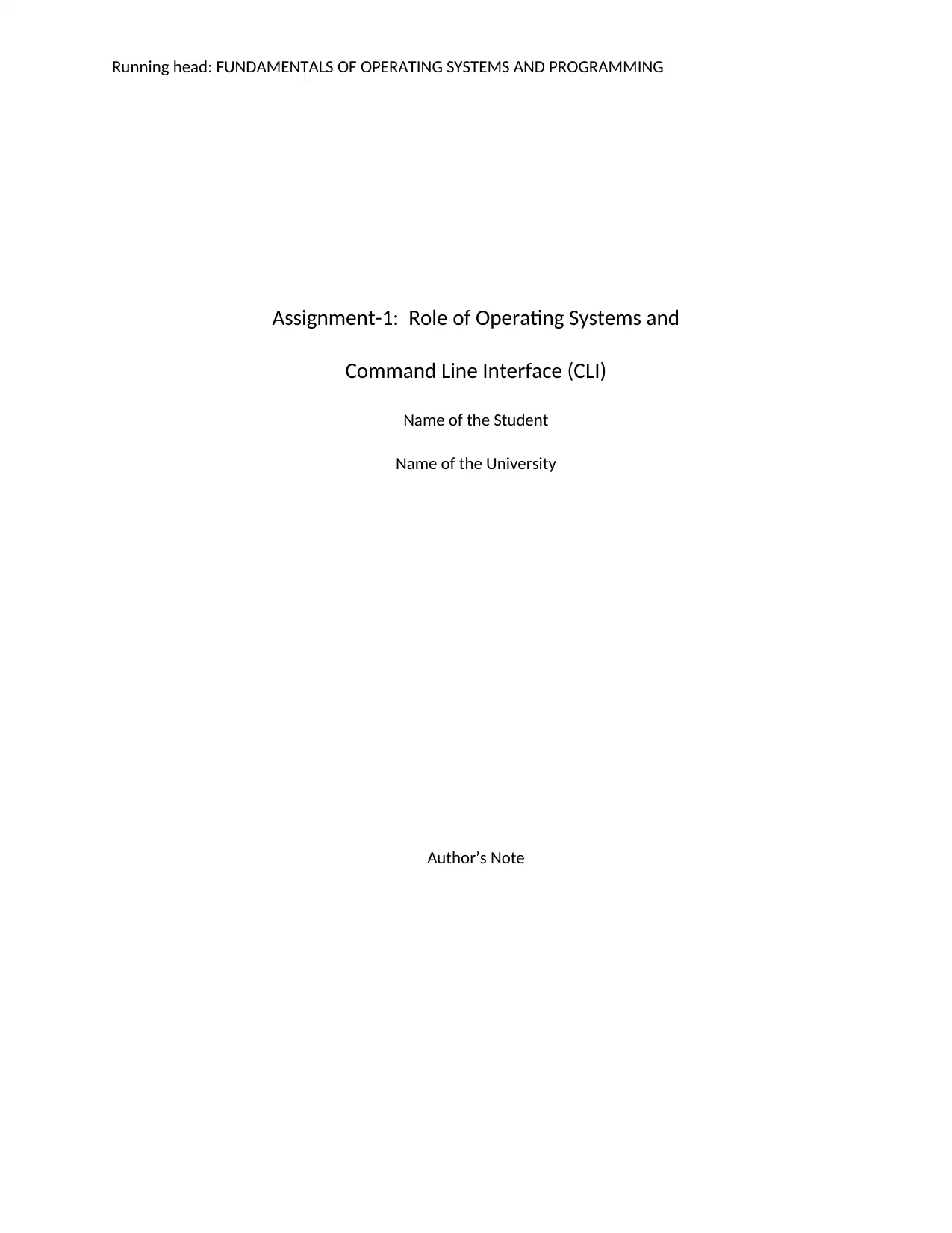
Running head: FUNDAMENTALS OF OPERATING SYSTEMS AND PROGRAMMING
Assignment-1: Role of Operating Systems and
Command Line Interface (CLI)
Name of the Student
Name of the University
Author’s Note
Assignment-1: Role of Operating Systems and
Command Line Interface (CLI)
Name of the Student
Name of the University
Author’s Note
Paraphrase This Document
Need a fresh take? Get an instant paraphrase of this document with our AI Paraphraser
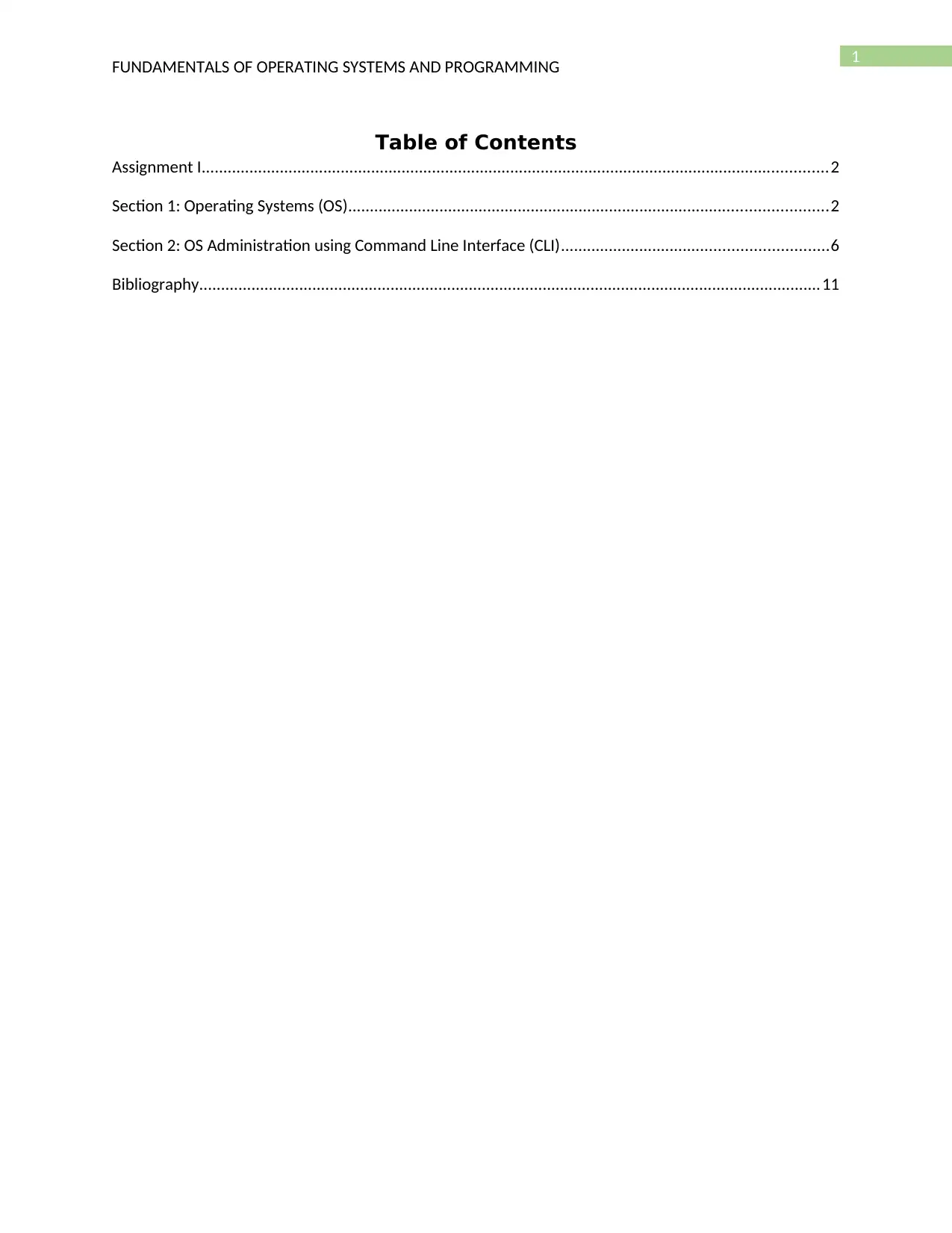
1
FUNDAMENTALS OF OPERATING SYSTEMS AND PROGRAMMING
Table of Contents
Assignment I................................................................................................................................................2
Section 1: Operating Systems (OS)..............................................................................................................2
Section 2: OS Administration using Command Line Interface (CLI).............................................................6
Bibliography...............................................................................................................................................11
FUNDAMENTALS OF OPERATING SYSTEMS AND PROGRAMMING
Table of Contents
Assignment I................................................................................................................................................2
Section 1: Operating Systems (OS)..............................................................................................................2
Section 2: OS Administration using Command Line Interface (CLI).............................................................6
Bibliography...............................................................................................................................................11
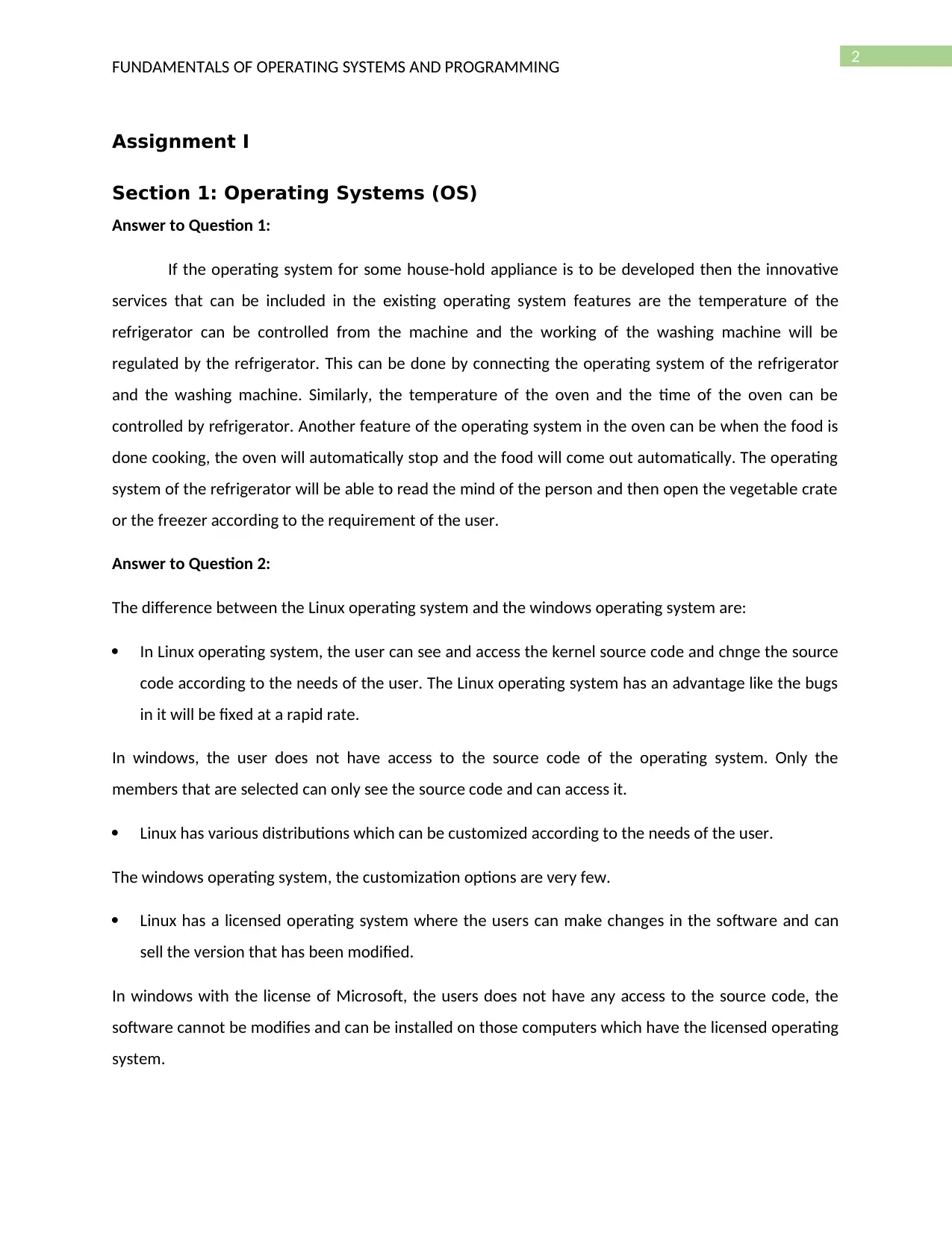
2
FUNDAMENTALS OF OPERATING SYSTEMS AND PROGRAMMING
Assignment I
Section 1: Operating Systems (OS)
Answer to Question 1:
If the operating system for some house-hold appliance is to be developed then the innovative
services that can be included in the existing operating system features are the temperature of the
refrigerator can be controlled from the machine and the working of the washing machine will be
regulated by the refrigerator. This can be done by connecting the operating system of the refrigerator
and the washing machine. Similarly, the temperature of the oven and the time of the oven can be
controlled by refrigerator. Another feature of the operating system in the oven can be when the food is
done cooking, the oven will automatically stop and the food will come out automatically. The operating
system of the refrigerator will be able to read the mind of the person and then open the vegetable crate
or the freezer according to the requirement of the user.
Answer to Question 2:
The difference between the Linux operating system and the windows operating system are:
In Linux operating system, the user can see and access the kernel source code and chnge the source
code according to the needs of the user. The Linux operating system has an advantage like the bugs
in it will be fixed at a rapid rate.
In windows, the user does not have access to the source code of the operating system. Only the
members that are selected can only see the source code and can access it.
Linux has various distributions which can be customized according to the needs of the user.
The windows operating system, the customization options are very few.
Linux has a licensed operating system where the users can make changes in the software and can
sell the version that has been modified.
In windows with the license of Microsoft, the users does not have any access to the source code, the
software cannot be modifies and can be installed on those computers which have the licensed operating
system.
FUNDAMENTALS OF OPERATING SYSTEMS AND PROGRAMMING
Assignment I
Section 1: Operating Systems (OS)
Answer to Question 1:
If the operating system for some house-hold appliance is to be developed then the innovative
services that can be included in the existing operating system features are the temperature of the
refrigerator can be controlled from the machine and the working of the washing machine will be
regulated by the refrigerator. This can be done by connecting the operating system of the refrigerator
and the washing machine. Similarly, the temperature of the oven and the time of the oven can be
controlled by refrigerator. Another feature of the operating system in the oven can be when the food is
done cooking, the oven will automatically stop and the food will come out automatically. The operating
system of the refrigerator will be able to read the mind of the person and then open the vegetable crate
or the freezer according to the requirement of the user.
Answer to Question 2:
The difference between the Linux operating system and the windows operating system are:
In Linux operating system, the user can see and access the kernel source code and chnge the source
code according to the needs of the user. The Linux operating system has an advantage like the bugs
in it will be fixed at a rapid rate.
In windows, the user does not have access to the source code of the operating system. Only the
members that are selected can only see the source code and can access it.
Linux has various distributions which can be customized according to the needs of the user.
The windows operating system, the customization options are very few.
Linux has a licensed operating system where the users can make changes in the software and can
sell the version that has been modified.
In windows with the license of Microsoft, the users does not have any access to the source code, the
software cannot be modifies and can be installed on those computers which have the licensed operating
system.
⊘ This is a preview!⊘
Do you want full access?
Subscribe today to unlock all pages.

Trusted by 1+ million students worldwide
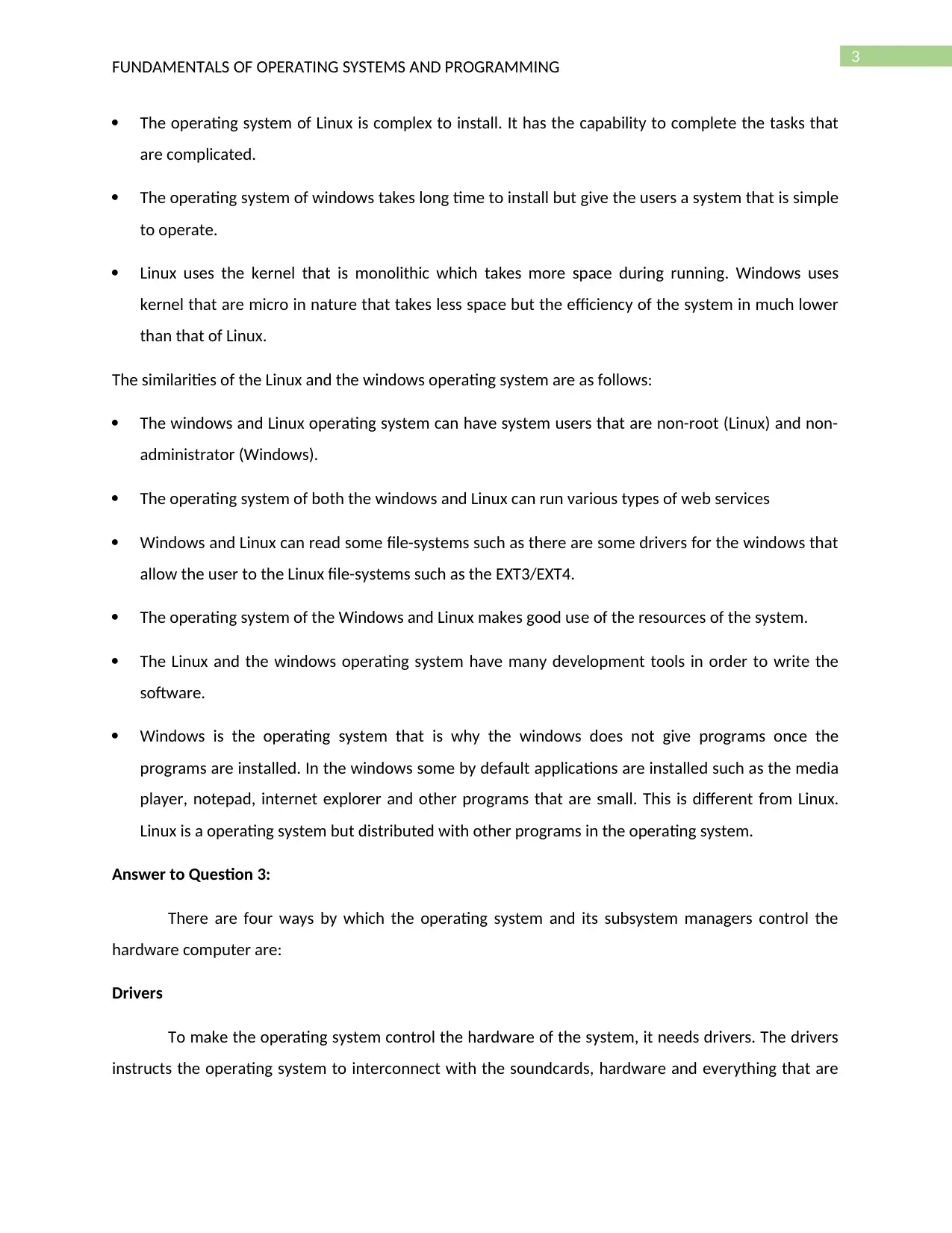
3
FUNDAMENTALS OF OPERATING SYSTEMS AND PROGRAMMING
The operating system of Linux is complex to install. It has the capability to complete the tasks that
are complicated.
The operating system of windows takes long time to install but give the users a system that is simple
to operate.
Linux uses the kernel that is monolithic which takes more space during running. Windows uses
kernel that are micro in nature that takes less space but the efficiency of the system in much lower
than that of Linux.
The similarities of the Linux and the windows operating system are as follows:
The windows and Linux operating system can have system users that are non-root (Linux) and non-
administrator (Windows).
The operating system of both the windows and Linux can run various types of web services
Windows and Linux can read some file-systems such as there are some drivers for the windows that
allow the user to the Linux file-systems such as the EXT3/EXT4.
The operating system of the Windows and Linux makes good use of the resources of the system.
The Linux and the windows operating system have many development tools in order to write the
software.
Windows is the operating system that is why the windows does not give programs once the
programs are installed. In the windows some by default applications are installed such as the media
player, notepad, internet explorer and other programs that are small. This is different from Linux.
Linux is a operating system but distributed with other programs in the operating system.
Answer to Question 3:
There are four ways by which the operating system and its subsystem managers control the
hardware computer are:
Drivers
To make the operating system control the hardware of the system, it needs drivers. The drivers
instructs the operating system to interconnect with the soundcards, hardware and everything that are
FUNDAMENTALS OF OPERATING SYSTEMS AND PROGRAMMING
The operating system of Linux is complex to install. It has the capability to complete the tasks that
are complicated.
The operating system of windows takes long time to install but give the users a system that is simple
to operate.
Linux uses the kernel that is monolithic which takes more space during running. Windows uses
kernel that are micro in nature that takes less space but the efficiency of the system in much lower
than that of Linux.
The similarities of the Linux and the windows operating system are as follows:
The windows and Linux operating system can have system users that are non-root (Linux) and non-
administrator (Windows).
The operating system of both the windows and Linux can run various types of web services
Windows and Linux can read some file-systems such as there are some drivers for the windows that
allow the user to the Linux file-systems such as the EXT3/EXT4.
The operating system of the Windows and Linux makes good use of the resources of the system.
The Linux and the windows operating system have many development tools in order to write the
software.
Windows is the operating system that is why the windows does not give programs once the
programs are installed. In the windows some by default applications are installed such as the media
player, notepad, internet explorer and other programs that are small. This is different from Linux.
Linux is a operating system but distributed with other programs in the operating system.
Answer to Question 3:
There are four ways by which the operating system and its subsystem managers control the
hardware computer are:
Drivers
To make the operating system control the hardware of the system, it needs drivers. The drivers
instructs the operating system to interconnect with the soundcards, hardware and everything that are
Paraphrase This Document
Need a fresh take? Get an instant paraphrase of this document with our AI Paraphraser
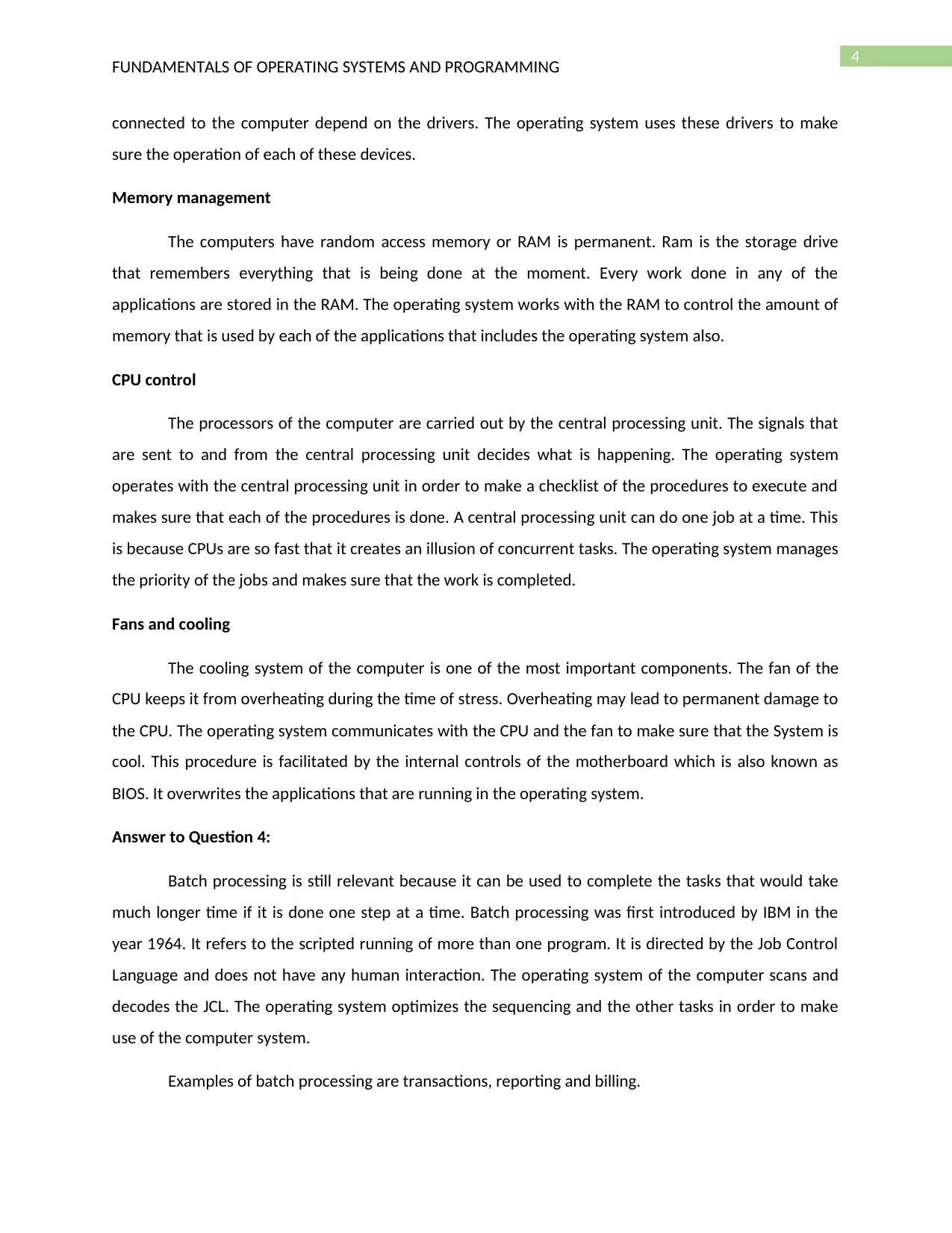
4
FUNDAMENTALS OF OPERATING SYSTEMS AND PROGRAMMING
connected to the computer depend on the drivers. The operating system uses these drivers to make
sure the operation of each of these devices.
Memory management
The computers have random access memory or RAM is permanent. Ram is the storage drive
that remembers everything that is being done at the moment. Every work done in any of the
applications are stored in the RAM. The operating system works with the RAM to control the amount of
memory that is used by each of the applications that includes the operating system also.
CPU control
The processors of the computer are carried out by the central processing unit. The signals that
are sent to and from the central processing unit decides what is happening. The operating system
operates with the central processing unit in order to make a checklist of the procedures to execute and
makes sure that each of the procedures is done. A central processing unit can do one job at a time. This
is because CPUs are so fast that it creates an illusion of concurrent tasks. The operating system manages
the priority of the jobs and makes sure that the work is completed.
Fans and cooling
The cooling system of the computer is one of the most important components. The fan of the
CPU keeps it from overheating during the time of stress. Overheating may lead to permanent damage to
the CPU. The operating system communicates with the CPU and the fan to make sure that the System is
cool. This procedure is facilitated by the internal controls of the motherboard which is also known as
BIOS. It overwrites the applications that are running in the operating system.
Answer to Question 4:
Batch processing is still relevant because it can be used to complete the tasks that would take
much longer time if it is done one step at a time. Batch processing was first introduced by IBM in the
year 1964. It refers to the scripted running of more than one program. It is directed by the Job Control
Language and does not have any human interaction. The operating system of the computer scans and
decodes the JCL. The operating system optimizes the sequencing and the other tasks in order to make
use of the computer system.
Examples of batch processing are transactions, reporting and billing.
FUNDAMENTALS OF OPERATING SYSTEMS AND PROGRAMMING
connected to the computer depend on the drivers. The operating system uses these drivers to make
sure the operation of each of these devices.
Memory management
The computers have random access memory or RAM is permanent. Ram is the storage drive
that remembers everything that is being done at the moment. Every work done in any of the
applications are stored in the RAM. The operating system works with the RAM to control the amount of
memory that is used by each of the applications that includes the operating system also.
CPU control
The processors of the computer are carried out by the central processing unit. The signals that
are sent to and from the central processing unit decides what is happening. The operating system
operates with the central processing unit in order to make a checklist of the procedures to execute and
makes sure that each of the procedures is done. A central processing unit can do one job at a time. This
is because CPUs are so fast that it creates an illusion of concurrent tasks. The operating system manages
the priority of the jobs and makes sure that the work is completed.
Fans and cooling
The cooling system of the computer is one of the most important components. The fan of the
CPU keeps it from overheating during the time of stress. Overheating may lead to permanent damage to
the CPU. The operating system communicates with the CPU and the fan to make sure that the System is
cool. This procedure is facilitated by the internal controls of the motherboard which is also known as
BIOS. It overwrites the applications that are running in the operating system.
Answer to Question 4:
Batch processing is still relevant because it can be used to complete the tasks that would take
much longer time if it is done one step at a time. Batch processing was first introduced by IBM in the
year 1964. It refers to the scripted running of more than one program. It is directed by the Job Control
Language and does not have any human interaction. The operating system of the computer scans and
decodes the JCL. The operating system optimizes the sequencing and the other tasks in order to make
use of the computer system.
Examples of batch processing are transactions, reporting and billing.
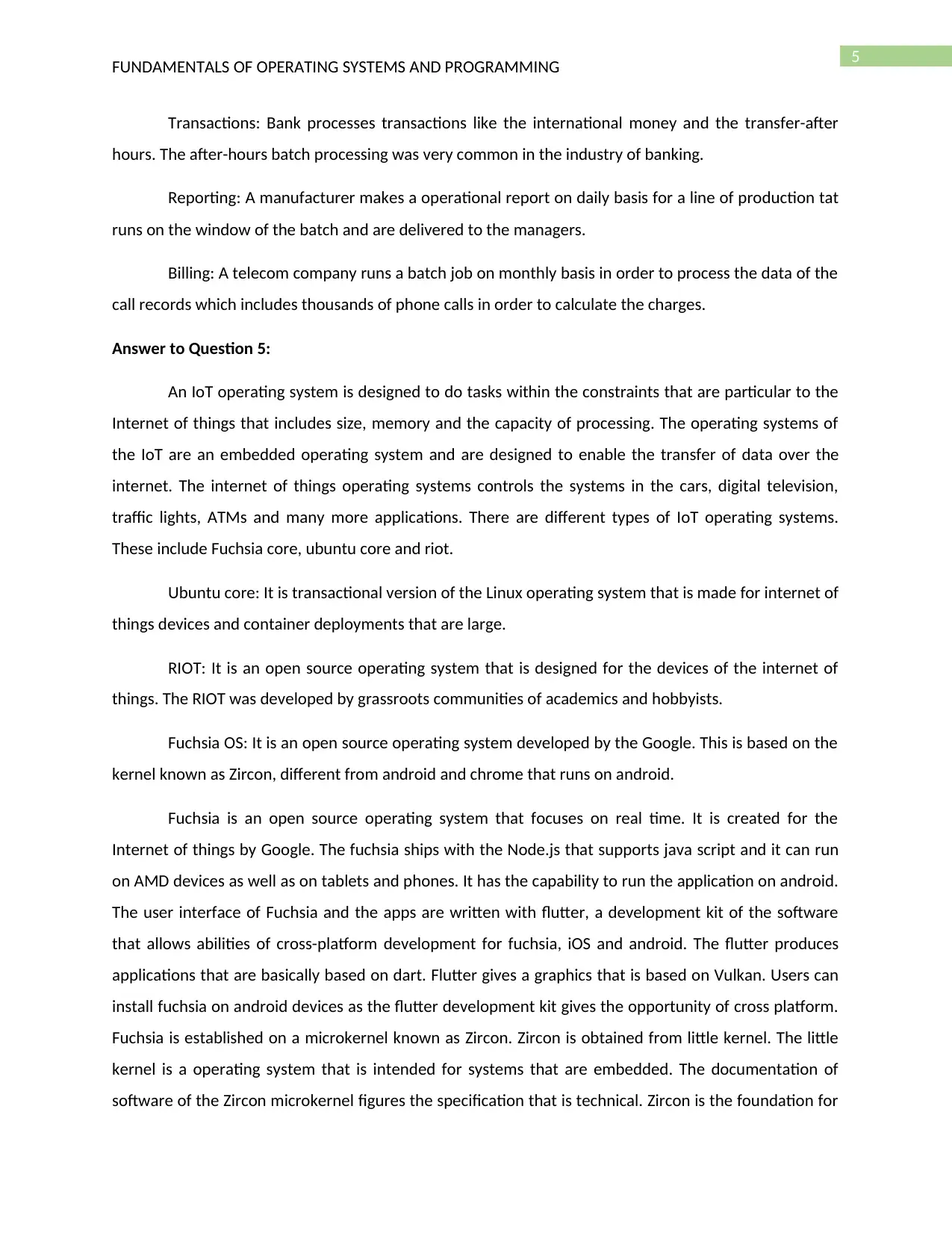
5
FUNDAMENTALS OF OPERATING SYSTEMS AND PROGRAMMING
Transactions: Bank processes transactions like the international money and the transfer-after
hours. The after-hours batch processing was very common in the industry of banking.
Reporting: A manufacturer makes a operational report on daily basis for a line of production tat
runs on the window of the batch and are delivered to the managers.
Billing: A telecom company runs a batch job on monthly basis in order to process the data of the
call records which includes thousands of phone calls in order to calculate the charges.
Answer to Question 5:
An IoT operating system is designed to do tasks within the constraints that are particular to the
Internet of things that includes size, memory and the capacity of processing. The operating systems of
the IoT are an embedded operating system and are designed to enable the transfer of data over the
internet. The internet of things operating systems controls the systems in the cars, digital television,
traffic lights, ATMs and many more applications. There are different types of IoT operating systems.
These include Fuchsia core, ubuntu core and riot.
Ubuntu core: It is transactional version of the Linux operating system that is made for internet of
things devices and container deployments that are large.
RIOT: It is an open source operating system that is designed for the devices of the internet of
things. The RIOT was developed by grassroots communities of academics and hobbyists.
Fuchsia OS: It is an open source operating system developed by the Google. This is based on the
kernel known as Zircon, different from android and chrome that runs on android.
Fuchsia is an open source operating system that focuses on real time. It is created for the
Internet of things by Google. The fuchsia ships with the Node.js that supports java script and it can run
on AMD devices as well as on tablets and phones. It has the capability to run the application on android.
The user interface of Fuchsia and the apps are written with flutter, a development kit of the software
that allows abilities of cross-platform development for fuchsia, iOS and android. The flutter produces
applications that are basically based on dart. Flutter gives a graphics that is based on Vulkan. Users can
install fuchsia on android devices as the flutter development kit gives the opportunity of cross platform.
Fuchsia is established on a microkernel known as Zircon. Zircon is obtained from little kernel. The little
kernel is a operating system that is intended for systems that are embedded. The documentation of
software of the Zircon microkernel figures the specification that is technical. Zircon is the foundation for
FUNDAMENTALS OF OPERATING SYSTEMS AND PROGRAMMING
Transactions: Bank processes transactions like the international money and the transfer-after
hours. The after-hours batch processing was very common in the industry of banking.
Reporting: A manufacturer makes a operational report on daily basis for a line of production tat
runs on the window of the batch and are delivered to the managers.
Billing: A telecom company runs a batch job on monthly basis in order to process the data of the
call records which includes thousands of phone calls in order to calculate the charges.
Answer to Question 5:
An IoT operating system is designed to do tasks within the constraints that are particular to the
Internet of things that includes size, memory and the capacity of processing. The operating systems of
the IoT are an embedded operating system and are designed to enable the transfer of data over the
internet. The internet of things operating systems controls the systems in the cars, digital television,
traffic lights, ATMs and many more applications. There are different types of IoT operating systems.
These include Fuchsia core, ubuntu core and riot.
Ubuntu core: It is transactional version of the Linux operating system that is made for internet of
things devices and container deployments that are large.
RIOT: It is an open source operating system that is designed for the devices of the internet of
things. The RIOT was developed by grassroots communities of academics and hobbyists.
Fuchsia OS: It is an open source operating system developed by the Google. This is based on the
kernel known as Zircon, different from android and chrome that runs on android.
Fuchsia is an open source operating system that focuses on real time. It is created for the
Internet of things by Google. The fuchsia ships with the Node.js that supports java script and it can run
on AMD devices as well as on tablets and phones. It has the capability to run the application on android.
The user interface of Fuchsia and the apps are written with flutter, a development kit of the software
that allows abilities of cross-platform development for fuchsia, iOS and android. The flutter produces
applications that are basically based on dart. Flutter gives a graphics that is based on Vulkan. Users can
install fuchsia on android devices as the flutter development kit gives the opportunity of cross platform.
Fuchsia is established on a microkernel known as Zircon. Zircon is obtained from little kernel. The little
kernel is a operating system that is intended for systems that are embedded. The documentation of
software of the Zircon microkernel figures the specification that is technical. Zircon is the foundation for
⊘ This is a preview!⊘
Do you want full access?
Subscribe today to unlock all pages.

Trusted by 1+ million students worldwide
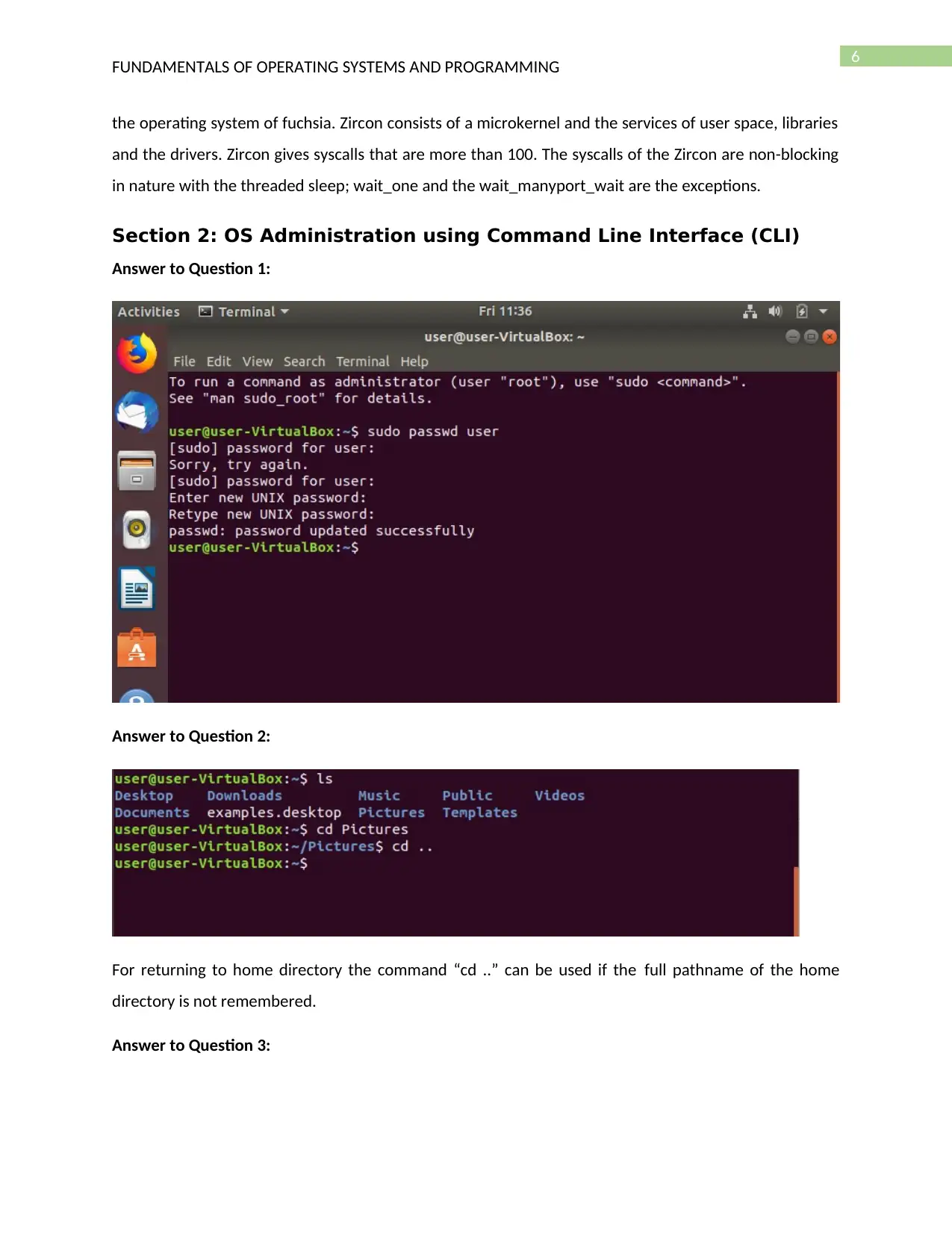
6
FUNDAMENTALS OF OPERATING SYSTEMS AND PROGRAMMING
the operating system of fuchsia. Zircon consists of a microkernel and the services of user space, libraries
and the drivers. Zircon gives syscalls that are more than 100. The syscalls of the Zircon are non-blocking
in nature with the threaded sleep; wait_one and the wait_manyport_wait are the exceptions.
Section 2: OS Administration using Command Line Interface (CLI)
Answer to Question 1:
Answer to Question 2:
For returning to home directory the command “cd ..” can be used if the full pathname of the home
directory is not remembered.
Answer to Question 3:
FUNDAMENTALS OF OPERATING SYSTEMS AND PROGRAMMING
the operating system of fuchsia. Zircon consists of a microkernel and the services of user space, libraries
and the drivers. Zircon gives syscalls that are more than 100. The syscalls of the Zircon are non-blocking
in nature with the threaded sleep; wait_one and the wait_manyport_wait are the exceptions.
Section 2: OS Administration using Command Line Interface (CLI)
Answer to Question 1:
Answer to Question 2:
For returning to home directory the command “cd ..” can be used if the full pathname of the home
directory is not remembered.
Answer to Question 3:
Paraphrase This Document
Need a fresh take? Get an instant paraphrase of this document with our AI Paraphraser
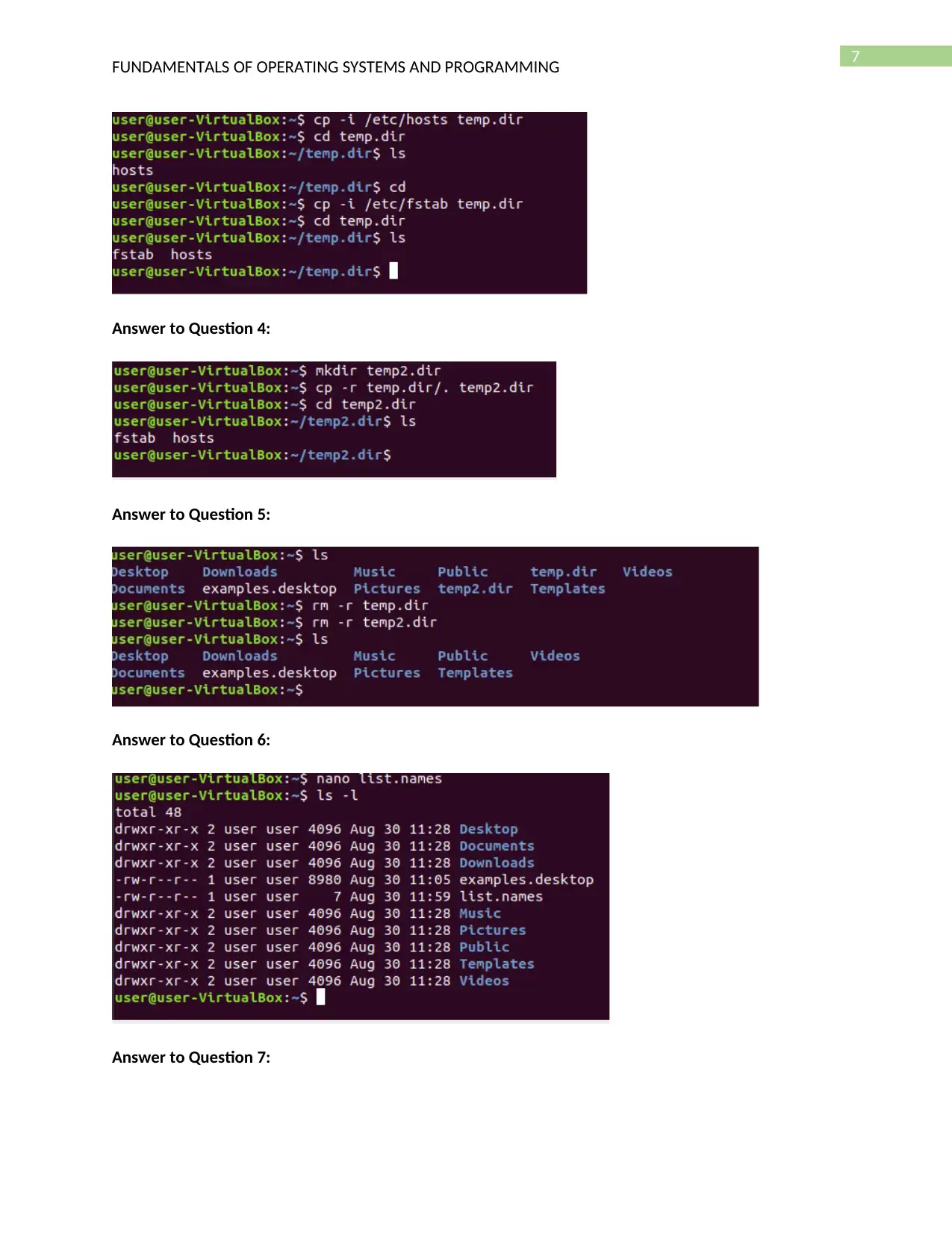
7
FUNDAMENTALS OF OPERATING SYSTEMS AND PROGRAMMING
Answer to Question 4:
Answer to Question 5:
Answer to Question 6:
Answer to Question 7:
FUNDAMENTALS OF OPERATING SYSTEMS AND PROGRAMMING
Answer to Question 4:
Answer to Question 5:
Answer to Question 6:
Answer to Question 7:
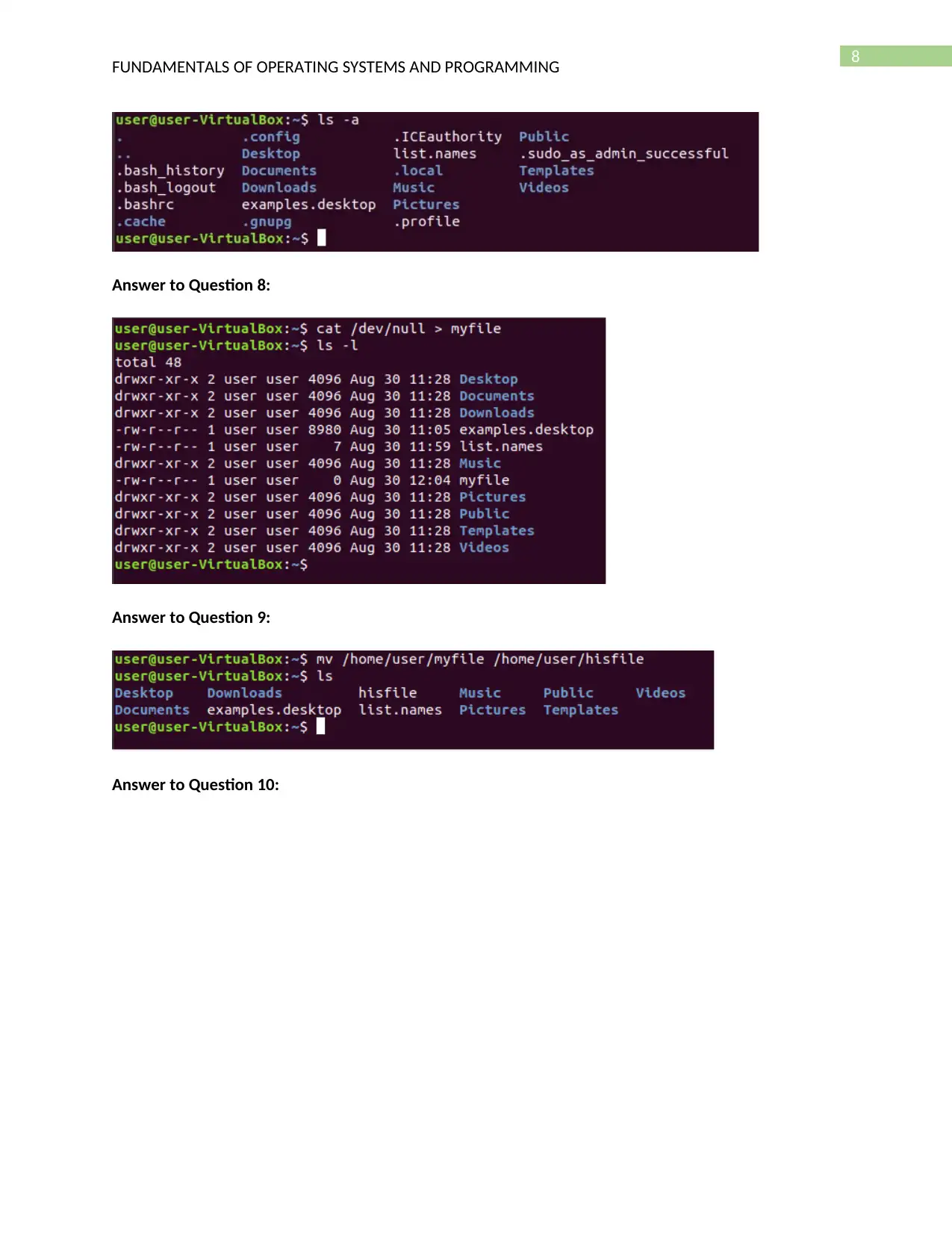
8
FUNDAMENTALS OF OPERATING SYSTEMS AND PROGRAMMING
Answer to Question 8:
Answer to Question 9:
Answer to Question 10:
FUNDAMENTALS OF OPERATING SYSTEMS AND PROGRAMMING
Answer to Question 8:
Answer to Question 9:
Answer to Question 10:
⊘ This is a preview!⊘
Do you want full access?
Subscribe today to unlock all pages.

Trusted by 1+ million students worldwide
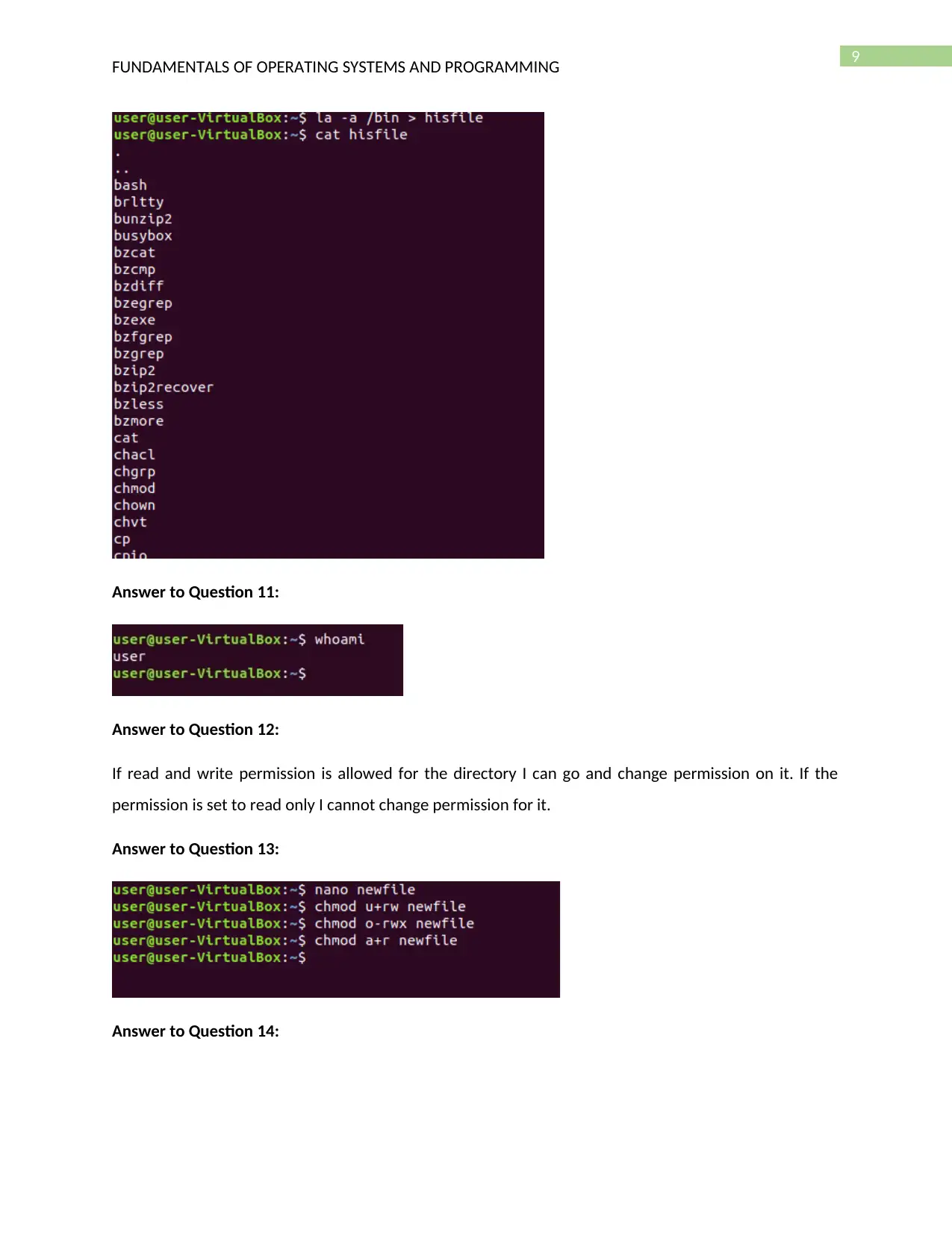
9
FUNDAMENTALS OF OPERATING SYSTEMS AND PROGRAMMING
Answer to Question 11:
Answer to Question 12:
If read and write permission is allowed for the directory I can go and change permission on it. If the
permission is set to read only I cannot change permission for it.
Answer to Question 13:
Answer to Question 14:
FUNDAMENTALS OF OPERATING SYSTEMS AND PROGRAMMING
Answer to Question 11:
Answer to Question 12:
If read and write permission is allowed for the directory I can go and change permission on it. If the
permission is set to read only I cannot change permission for it.
Answer to Question 13:
Answer to Question 14:
Paraphrase This Document
Need a fresh take? Get an instant paraphrase of this document with our AI Paraphraser
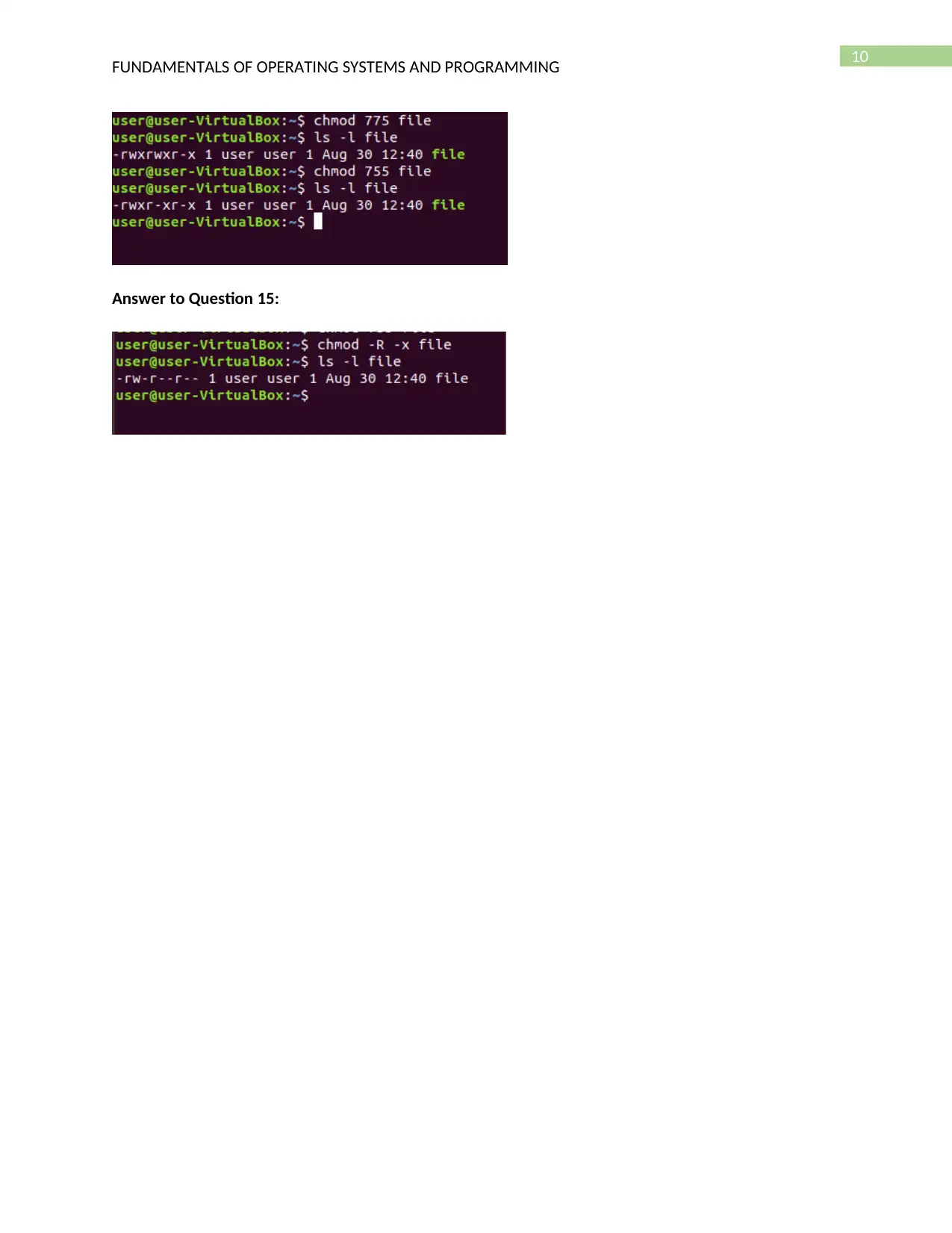
10
FUNDAMENTALS OF OPERATING SYSTEMS AND PROGRAMMING
Answer to Question 15:
FUNDAMENTALS OF OPERATING SYSTEMS AND PROGRAMMING
Answer to Question 15:
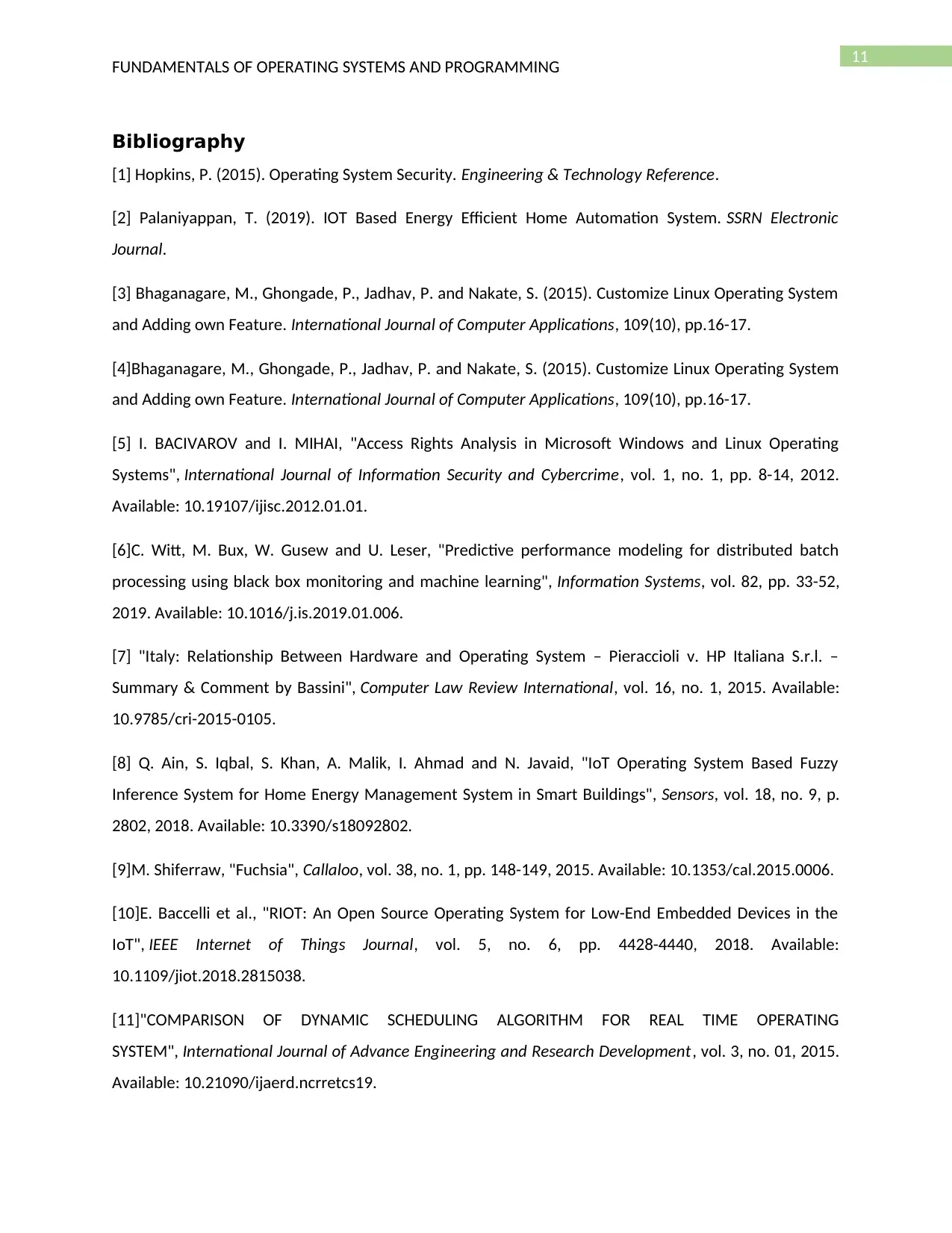
11
FUNDAMENTALS OF OPERATING SYSTEMS AND PROGRAMMING
Bibliography
[1] Hopkins, P. (2015). Operating System Security. Engineering & Technology Reference.
[2] Palaniyappan, T. (2019). IOT Based Energy Efficient Home Automation System. SSRN Electronic
Journal.
[3] Bhaganagare, M., Ghongade, P., Jadhav, P. and Nakate, S. (2015). Customize Linux Operating System
and Adding own Feature. International Journal of Computer Applications, 109(10), pp.16-17.
[4]Bhaganagare, M., Ghongade, P., Jadhav, P. and Nakate, S. (2015). Customize Linux Operating System
and Adding own Feature. International Journal of Computer Applications, 109(10), pp.16-17.
[5] I. BACIVAROV and I. MIHAI, "Access Rights Analysis in Microsoft Windows and Linux Operating
Systems", International Journal of Information Security and Cybercrime, vol. 1, no. 1, pp. 8-14, 2012.
Available: 10.19107/ijisc.2012.01.01.
[6]C. Witt, M. Bux, W. Gusew and U. Leser, "Predictive performance modeling for distributed batch
processing using black box monitoring and machine learning", Information Systems, vol. 82, pp. 33-52,
2019. Available: 10.1016/j.is.2019.01.006.
[7] "Italy: Relationship Between Hardware and Operating System – Pieraccioli v. HP Italiana S.r.l. –
Summary & Comment by Bassini", Computer Law Review International, vol. 16, no. 1, 2015. Available:
10.9785/cri-2015-0105.
[8] Q. Ain, S. Iqbal, S. Khan, A. Malik, I. Ahmad and N. Javaid, "IoT Operating System Based Fuzzy
Inference System for Home Energy Management System in Smart Buildings", Sensors, vol. 18, no. 9, p.
2802, 2018. Available: 10.3390/s18092802.
[9]M. Shiferraw, "Fuchsia", Callaloo, vol. 38, no. 1, pp. 148-149, 2015. Available: 10.1353/cal.2015.0006.
[10]E. Baccelli et al., "RIOT: An Open Source Operating System for Low-End Embedded Devices in the
IoT", IEEE Internet of Things Journal, vol. 5, no. 6, pp. 4428-4440, 2018. Available:
10.1109/jiot.2018.2815038.
[11]"COMPARISON OF DYNAMIC SCHEDULING ALGORITHM FOR REAL TIME OPERATING
SYSTEM", International Journal of Advance Engineering and Research Development, vol. 3, no. 01, 2015.
Available: 10.21090/ijaerd.ncrretcs19.
FUNDAMENTALS OF OPERATING SYSTEMS AND PROGRAMMING
Bibliography
[1] Hopkins, P. (2015). Operating System Security. Engineering & Technology Reference.
[2] Palaniyappan, T. (2019). IOT Based Energy Efficient Home Automation System. SSRN Electronic
Journal.
[3] Bhaganagare, M., Ghongade, P., Jadhav, P. and Nakate, S. (2015). Customize Linux Operating System
and Adding own Feature. International Journal of Computer Applications, 109(10), pp.16-17.
[4]Bhaganagare, M., Ghongade, P., Jadhav, P. and Nakate, S. (2015). Customize Linux Operating System
and Adding own Feature. International Journal of Computer Applications, 109(10), pp.16-17.
[5] I. BACIVAROV and I. MIHAI, "Access Rights Analysis in Microsoft Windows and Linux Operating
Systems", International Journal of Information Security and Cybercrime, vol. 1, no. 1, pp. 8-14, 2012.
Available: 10.19107/ijisc.2012.01.01.
[6]C. Witt, M. Bux, W. Gusew and U. Leser, "Predictive performance modeling for distributed batch
processing using black box monitoring and machine learning", Information Systems, vol. 82, pp. 33-52,
2019. Available: 10.1016/j.is.2019.01.006.
[7] "Italy: Relationship Between Hardware and Operating System – Pieraccioli v. HP Italiana S.r.l. –
Summary & Comment by Bassini", Computer Law Review International, vol. 16, no. 1, 2015. Available:
10.9785/cri-2015-0105.
[8] Q. Ain, S. Iqbal, S. Khan, A. Malik, I. Ahmad and N. Javaid, "IoT Operating System Based Fuzzy
Inference System for Home Energy Management System in Smart Buildings", Sensors, vol. 18, no. 9, p.
2802, 2018. Available: 10.3390/s18092802.
[9]M. Shiferraw, "Fuchsia", Callaloo, vol. 38, no. 1, pp. 148-149, 2015. Available: 10.1353/cal.2015.0006.
[10]E. Baccelli et al., "RIOT: An Open Source Operating System for Low-End Embedded Devices in the
IoT", IEEE Internet of Things Journal, vol. 5, no. 6, pp. 4428-4440, 2018. Available:
10.1109/jiot.2018.2815038.
[11]"COMPARISON OF DYNAMIC SCHEDULING ALGORITHM FOR REAL TIME OPERATING
SYSTEM", International Journal of Advance Engineering and Research Development, vol. 3, no. 01, 2015.
Available: 10.21090/ijaerd.ncrretcs19.
⊘ This is a preview!⊘
Do you want full access?
Subscribe today to unlock all pages.

Trusted by 1+ million students worldwide
1 out of 13
Related Documents
Your All-in-One AI-Powered Toolkit for Academic Success.
+13062052269
info@desklib.com
Available 24*7 on WhatsApp / Email
![[object Object]](/_next/static/media/star-bottom.7253800d.svg)
Unlock your academic potential
Copyright © 2020–2025 A2Z Services. All Rights Reserved. Developed and managed by ZUCOL.





![Server Installation and Management Project - [Course Name] [Semester]](/_next/image/?url=https%3A%2F%2Fdesklib.com%2Fmedia%2Fimages%2Fkl%2F1a2c109da7e14c78a6b2e8ca6dd132c5.jpg&w=256&q=75)